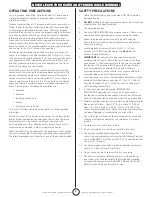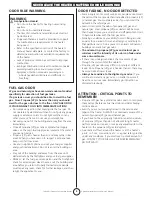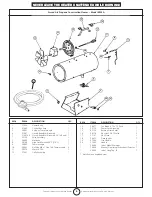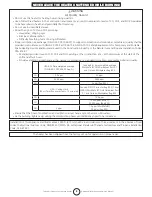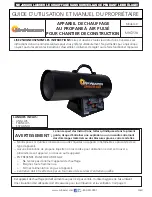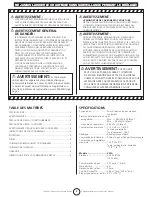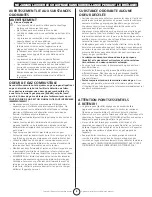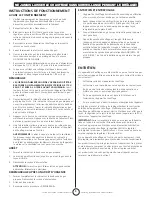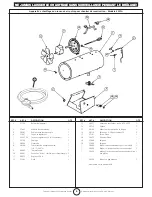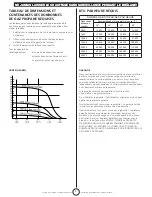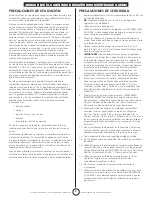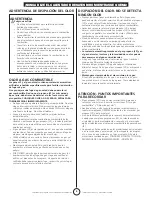
8
Forced Air Propane Construction Heater
Operating Instructions and Owner’s Manual
NEVER LEAVE THE HEATER UNATTENDED WHILE BURNING!
NEVER LEAVE THE HEATER UNATTENDED WHILE BURNING!
NEVER LEAVE THE HEATER UNATTENDED WHILE BURNING!
WARNING
Air Quality Hazard
• Do not use this heater for heating human living quarters.
• Use of direct-fired heaters in the construction environment can result in exposure to levels of CO, CO2, and NO2 considered
to be hazardous to health and potentially life threatening.
• Do not use in unventilated areas.
• Know the signs of CO and CO2 poisoning.
• Headaches, stinging eyes
• Dizziness, disorientation
• Difficulty breathing, feels of being suffocated
• Proper ventilation air exchange (OSHA 29 CFR 1926.57) to support combustion and maintain acceptable air quality shall be
provided in accordance with OSHA 29 CFR Part 1926.154, ANSI A10.10 Safety Requirements for Temporary and Portable
Space Heating Devices and Equipment used in the Construction Industry or the Natural Gas and Propane Installation Codes
CSA B149.1.
• Periodically monitor levels of CO, CO2 and NO2 existing at the construction site – at the minimum at the start of the
shift and after 4 hours.
• Provide ventilation air exchange, either natural or mechanical, as required to maintain acceptable indoor air quality.
USA 8-Hr Time weighted average
(OSHA 29 CFR 1926.55 App A)
Canada 8-hr time weighted average
WorkSafe BC OHS Guidelines Part 5.1
and Ontario Workplaces Reg 833
CO
50 ppm
25 ppm
CO
2
5000 ppm
5000 ppm
NO
2
3 ppm (Reg 833)
USA – Ceiling Limit
(Short Term Exposure Limit = 15 minutes)
Canada STEL (15 minutes Reg 833/1 hour
WSBC) WorkSafe BC OHS Guidelines Part
5.1 and Ontario Workplaces Reg 833
CO
100 ppm
CO
2
15000 ppm (WSBC)
30000 ppm (Reg 833)
NO
2
5 ppm
1.0 ppm (WorkSafeBC)
5.0 ppm (Reg 833)
• Ensure that the flow of combustion and ventilation air exchange cannot become obstructed.
• As the building ‘tightens up’ during the construction phases ventilation may need to be increased.
Installation of this appliance at altitudes above 2000 ft (610 m) shall be in accordance with local codes, or in the absence of local
codes, the National Fuel Gas Code, ANSI Z223.1/NFPA 54, or National Standard of Canada, Natural Gas and Propane Installation
Code, CSA B149.1
The heater has been shipped from the factory set up for operation on propane gas.



